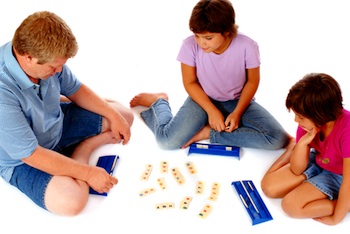Classroom math games are like an invitation to a math party! Using games will engage and give you critical insights into student thinking.
One of the goals of mathematics is to create a culture that embraces learning and the way students think about math. We also know that when teachers consistently embrace positive attitudes about math in their classrooms, students show gains in their understanding.
You absolutely do not need to purchase anything expensive or fancy to play games in the classroom. You probably have everything you need already!
Math practice games should be practical, easy to implement and empower students to come up with their own approaches to problem solving.
These are very easy classroom math games. They require higher order thinking and the ability for students to share their discoveries
Easy Math Practice Games
These classroom math games are perfect for whole class or partners. I have also used them for math center games.
Search for Patterns
Make a list of numbers that begin with a “starting number.” Increase by a fixed amount called a “jump number.”
For example, start with 2 and use the jump number of 5. Write the start number at the top of your paper then start “jumping.” Stop when you reach 97.
Examine the list of numbers and share as many patterns as you can find with your group.
Questions about patterns you may find are:
- Is there an alternating pattern?
- Is there a pattern of odd and even numbers?
- What happens to the numbers in the tens place?
It is quite insightful to what the students observe with this math game. Try changing the start and jump numbers and see what is the same and different. Or, keep the same start number but only change the jump number.
Use playing cards for younger students, or make your own with index cards and numbers written on them..
Apples and Bananas
Use two colors of counters. Set out 24, 16 of them being red and 8 being yellow.
Group the counters into different parts of the whole. use the parts of create fraction names. Depending on the grade level, you may wish to do this together, independently, or a mixture of both.
For example, we could show that 16/24 are apples, and 8/24 are bananas. Then, make the 16 reds into 4 groups of 4. The yellows are 2 groups of 4. Now we have 4/6 groups are apples and 2/6 groups are bananas.
Take the 16 red and make 2 groups of 8. The yellow becomes 1 group of 8. Our fractions now are 2/3 groups are apples and 1/3 groups are bananas.
The interesting part comes when we allow students to make self-discoveries about what fractions are and how a whole can be divided into equal parts. Their oral talk is key here to further developing their understanding.
This lesson is from Elementary and Middle School Mathematics: Teaching Developmentally (7th Edition). If you really want to understand about classroom math games and how to teach math, you need this book.
A Sticky Situation
For this activity you will need a few sets of stickers that are all related: fish, mammals, sports, etc. Make a set of cards by putting one sticker from the sets on index cards. You will need 10-15 cards if this will be a center. As a whole class activity, be sure there is a card for each student and they will need to find like members to make their groups.
The students need to group the cards by attributes found on the stickers. They should be able to group them in multiple ways and record their thinking in their math journals.
For example, they might group the stickers by size. Then the cards could be grouped by color. To make it more difficult, a sports theme might make groups by balls that are kicked, balls that are thrown, and balls that can be both kicked and thrown.
Finish the activity with a discussion about what attributes all the stickers have, which sticker is the most different and why, and find one attribute for each sticker that none of the other ones have.
